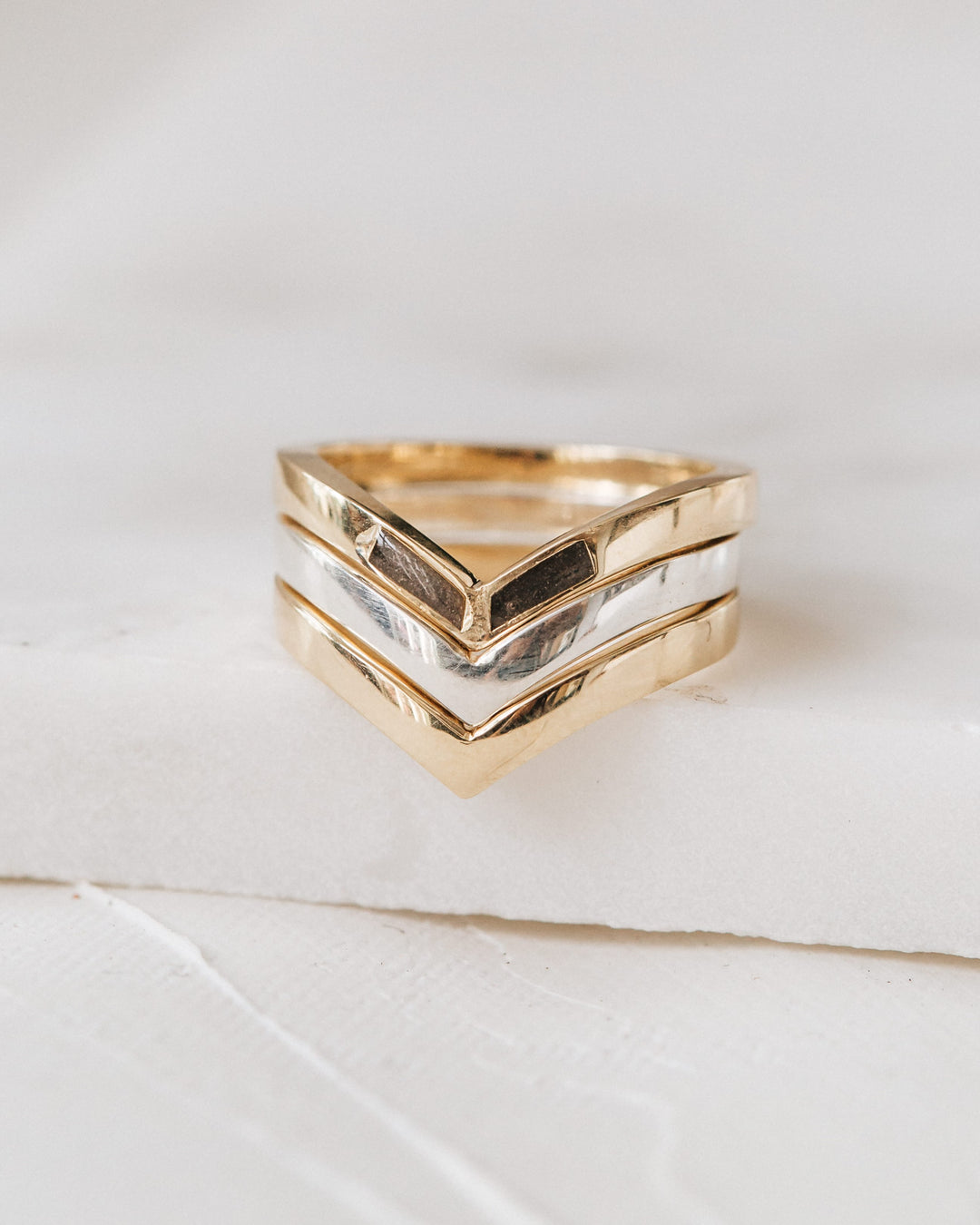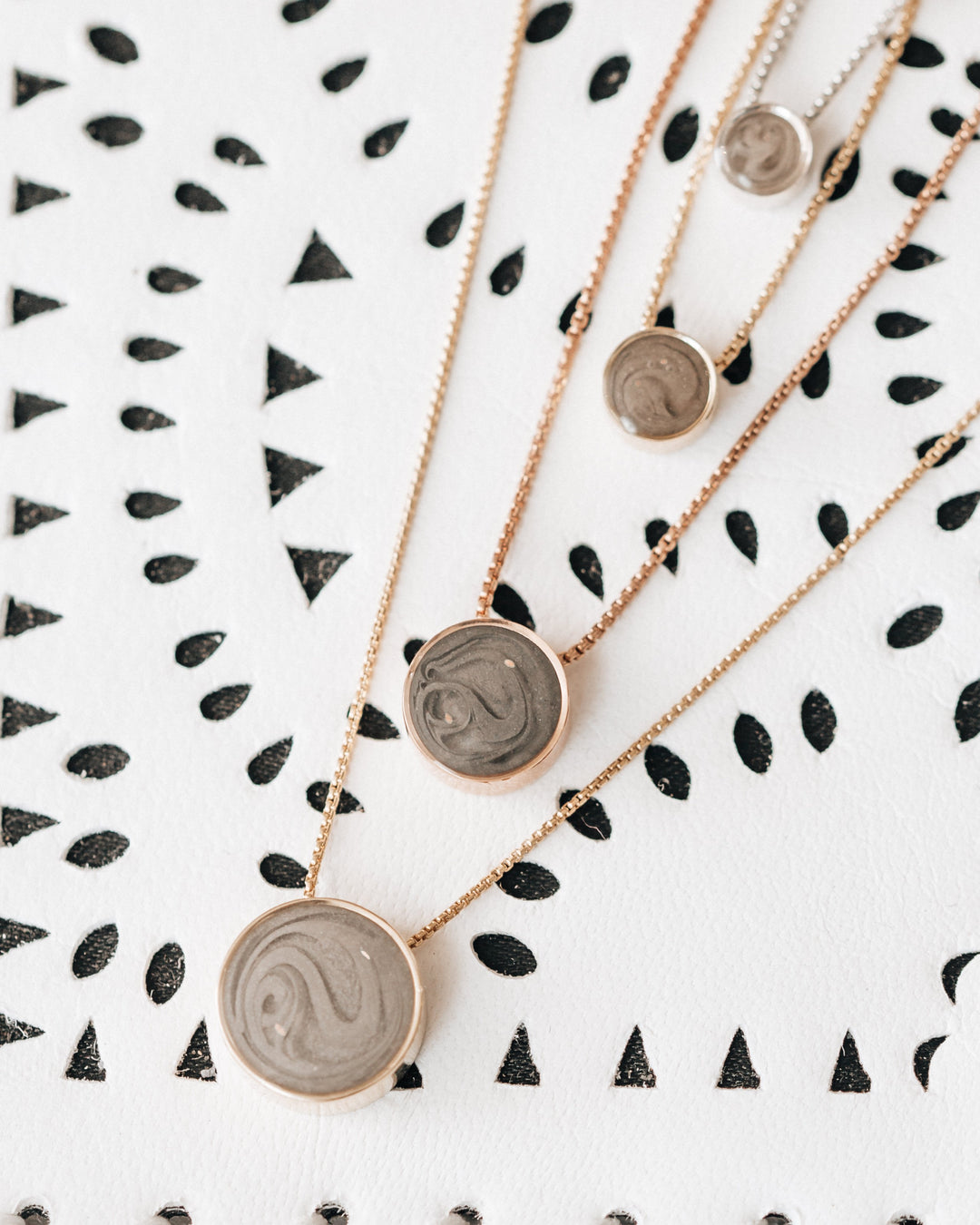Choosing the Right Metal for Your Memorial Jewelry

Pictured: Four Setting Ring in 14K Rose Gold, Two Setting Ring in 14K Yellow Gold, & Three Setting Ring in Sterling Silver
Most of our pieces come in the following metal choices: 14K Yellow Gold, 14K Rose Gold, 14K White Gold, and Sterling Silver. Clients often come to us and ask for help in determining which metal would be the best choice for them, and this inspired us to create the following comprehensive guide to understanding the physical properties of each of these metals, as well as the pros and cons and care instructions specific to each one. In addition, we have also compiled a list of our most frequently asked questions regarding, both directly and indirectly, metal choice. We hope the following information will be of assistance to you, but please do not hesitate to contact us if you have any questions or concerns that are not covered here!
14K YELLOW GOLD
14K Yellow Gold is not actually a metal in its own right, but rather an alloy (meaning combination) of gold mixed with other metals, specifically 58.3% gold and 41.7% other metals. These percentages come from the fact that one karat (K) of gold is 1/24th part of the whole; therefore, any gold with a purity measurement of 14K is made up of 14 parts gold (14/24 = 58.3%) and 10 parts (10/24 = 41.7%) other metals. The other metals in 14K Yellow Gold are typically silver and copper, which are used to provide strength and rigidity as well as contribute to the final color.
Note: 24K Gold is the highest possible karat level; it indicates that 24 out of 24 parts consist of gold, meaning it is 100% pure gold. 24K Gold has a very rich, saturated, yellow color. It is extremely soft, making it impractical for items that are worn or used frequently since it is easily scratched or bent. Our pieces can be cast in 18K Gold upon request, but we do not offer any higher-karat golds than this due to the difficulty in casting and fragility of the final product.
Special Care Instructions:
Avoid hitting, rubbing, or storing your 14K Yellow Gold piece with any abrasive or sharp objects or materials as these can scratch the metal. Exposure to chlorine or other harsh chemicals, such as those found in many household cleaning products, has been found to weaken or discolor 14K Gold, so it is best to remove your 14K Yellow Gold jewelry before swimming or doing housework. It is also advised to protect 14K Yellow Gold from lotions, perfumes, and other cosmetics or skincare products, as these can contain chemical compounds that are actually harder than the metal of your jewelry, which can cause tiny metal particles to rub off onto your skin -- a process known as metallic abrasion. Because of this, we recommend taking your 14K Yellow Gold jewelry off before showering or doing any routine involving the aforementioned products.
Because 14K Yellow Gold always contains a certain amount of copper, we suggest reading the Special Care Instructions for 14K Rose Gold below as well. Due to their similar physical makeup, precautions for one should be considered and taken for the other.
14K ROSE GOLD
Also referred to as "Pink Gold", 14K Rose Gold has a very similar metal makeup to 14K Yellow Gold as it is also made by combining gold with copper and silver. The difference is that 14K Yellow Gold contains significantly more silver in order to lighten the natural color of the pure gold in it, whereas 14K Rose Gold contains significantly more copper to create its famous rosy-pink hue.
Special Care Instructions:
The high copper content in 14K Rose Gold makes it very susceptible to corrosion from saltwater, chlorine, and even sweat. Saltwater and chlorine can not only discolor your 14K Rose Gold jewelry but also damage and weaken the metal, so if you are spending the day at the beach or the pool, we recommend leaving your 14K Rose Gold pieces at home.
For some people, a blue or green discoloration of the skin occurs when the copper in their jewelry comes into contact with their perspiration. This discoloration would be confined to the areas of skin that touched the jewelry, and would be able to be washed off. Since this is a result of the wearer's unique body chemistry, the only way to prevent this is to take off your 14K Rose Gold jewelry before engaging in exercise or other strenuous activity, and in very hot weather.
Blue or green discoloration of the skin can also occur when the copper content in 14K Rose Gold comes into contact and reacts with chemical compounds found in products such as makeup and lotions. We recommend removing your 14K Rose Gold jewelry before applying these products, and avoid applying them to the areas of your skin the jewelry will be resting against. A general rule of thumb is to ensure that the part of your body where your 14K Rose Gold jewelry will be touching is clean and dry.
14K WHITE GOLD
14K White Gold is an alloy (combination) of gold mixed with another metal, typically nickel, silver, or palladium. These other metals provide strength and rigidity and contribute to White Gold’s “white” color. However, the resulting metal still has a distinct yellowish cast, which is why most White Gold jewelry (and all of ours) comes rhodium plated. Rhodium is a precious metal within the platinum family; it is a bright, silvery-white metallic element that is strongly resistant to corrosion. The rhodium plating is responsible for the lustrous finish on our 14K White Gold pieces, as well as their higher price. Rhodium plating can wear off jewelry that has been worn a lot over a long period of time but, fortunately, 14K White Gold jewelry can always be replated, even after it is set with ashes.
Special Care Instructions:
While rhodium plating is added for its strength and durability in addition to its desirable color and shine, special care is still required to preserve the plating and extend its lifespan. One of the biggest threats to rhodium plating is any kind of excessive abrasion: Avoid rubbing your 14K White Gold jewelry with or against anything, and if you would like to wear your piece often, ensure that your skin (where the jewelry comes in contact with) is clean and dry, and free of lotions, perfumes, and soaps, which can contain ingredients that have the potential to wear down the plating.
If you would like to clean your 14K White Gold piece, we recommend soaking it in a bowl of warm water and mild soap, which is any soap that is free from harsh cleaning chemicals and safe for repeated contact with skin, such as a liquid dishwashing soap. To dry it afterwards, we recommend either letting it air-dry or patting it gently with a very soft cloth.
STERLING SILVER
Sterling Silver specifically refers to an alloy (combination) of 92.5% pure silver and 7.5% other metals, hence it being interchangeable with the term “.925 Sterling Silver”. The 7.5% that is not pure silver is typically copper, nickel, or zinc, but is often predominantly or entirely copper. Like 14K Gold, these metals are added to the pure silver in order to produce a stronger and more durable final product with an ideal color.
Special Care Instructions:
A common concern with purchasing Sterling Silver jewelry is that it will discolor or darken over time. This is called “tarnishing”, and tarnishing is actually a result of the jewelry coming into contact and reacting with sulfur. Given this, your Sterling Silver jewelry may be more prone to tarnishing if you live in an area of high humidity or in an urban or industrial area, as these have an increased amount of sulfur in the air. Additionally, sulfur or sulfur compounds are present in many soaps, cleansers, shampoos, and perfumes, so your Sterling Silver jewelry may require more maintenance if you often wear it during or after using such products. It has even been proven that preparing or eating a large number of sulfur-rich foods, such as eggs or onions, can affect your Sterling Silver jewelry, either by direct contact with the food or the sulfur later being excreted through perspiration. Tarnish only affects the very outer layers of the metal, and it can be cleaned off using a variety of methods or products, but to protect the ashes setting of your Sterling Silver piece, please see this blog post on how to safely remove and prevent tarnish.
Rhodium plating can be added to Sterling Silver jewelry to prevent tarnishing; this will also give it a finish very similar to that of 14K White Gold. However, as mentioned above in the discussion of 14K White Gold, jewelry with rhodium plating requires its own form of special care, and the rhodium plating may need to be redone after a long time of frequent wear.
FREQUENTLY ASKED QUESTIONS
I often get an allergic reaction to jewelry. Which metal would be best for me, so that this does not happen with such a special piece?
The most common culprit behind allergic reactions to jewelry is the presence of nickel. A person develops a nickel allergy when their immune system mistakenly classifies it as a harmful substance. It is unknown what exactly causes a person’s immune system to react to nickel in this way, but once it does, coming into contact with nickel-containing items produces an allergic reaction referred to as contact dermatitis. The symptoms of contact dermatitis -- which include redness, itching, and dryness -- typically start relatively quickly, anywhere from a couple hours to a couple days, and are usually confined to the area of skin that came into contact with the nickel-containing item. A person’s body can develop an allergy to nickel upon their first time coming into contact with it, but it is important to note that it is most common for a nickel allergy to develop only after prolonged or repeated contact with items containing it. If you are unsure if you have a nickel allergy but develop a skin rash on targeted areas of your body, it is best to see a doctor for a proper diagnosis.
We can use what we know about the various metal options above to try and deduce what the safest options would be for those with sensitive skin. Out of the 14K Gold options, 14K Yellow Gold and 14K Rose Gold are the least likely to have any nickel content, whereas it is not uncommon for 14K White Gold to contain nickel. That being said, the rhodium plating provided on 14K White Gold jewelry serves as a barrier and should prevent an allergic reaction from occurring for the lifespan of the plating. Sterling Silver may also contain nickel, but due to its higher purity, it would only be in very small or trace amounts. Taking all of this into account, we recommend using your best judgement based on your personal skin sensitivity history.
I want to wear my piece all of the time, but I have an active lifestyle that can be pretty rough on my jewelry. Which metal is the most durable, so that I could wear my piece without having to worry about it?
All of our pieces, regardless of their metal, should be treated as you would a fine piece of jewelry, such as an engagement ring or family heirloom. Although Sterling Silver and 14K Gold are considered the optimal metal choices for jewelry due to their ability to stand up to daily wear, they are intended for just that: to be worn. Both Sterling Silver and 14K Gold are capable of being scratched, chipped, or otherwise damaged. We always recommend being mindful of where you wear your piece and what you are doing while you wear it. That being said, we understand that accidents happen, so all of our pieces (excluding our Sale items) come with a 90-Day Warranty that covers the cost of jewelry repairs or replacement chains. If you are in need of these services after your 90-Day Warranty has expired, you may rest assured that we will still be happy to assist you in any way that we can.
The most vulnerable part of any piece, however, is its setting. The setting is the defining feature of our jewelry, and undoubtedly the most important part: It is the beautiful stone-like portion consisting of your loved one’s ashes. The care instructions for your piece’s setting may differ from those of its metal portion, so be sure to read through our post on Care and Cleaning for Resin Jewelry. All of our pieces, including Sale items, come with a lifetime warranty for the setting. This means that you can always send your piece back to us to have the setting repaired, restored, or reset, and we will never charge a service fee.
I want to choose the metal that will pair the best with my loved one’s ashes. How can I do this when I don’t know how the ashes will look in the finished piece yet?
Ashes are like fingerprints: entirely unique to your loved one. Our setting process showcases the natural color of the ashes, and no color is added to achieve a specific look or hue. The photos on our website are a good representation of the range of colors that ashes typically produce, but they are by no means all-encompassing. While settings tend to fall on either the gray or beige spectrums (unless your loved one was cremated via aquamation, in which case we recommend reading this article), we have come across a variety of other colors. It can be difficult to precisely predict what the finished setting will look like by just looking at the ashes since, before they are set, they are broken down into a fine powder and mixed with a clear, high-grade jewelry resin. Because of this, the various shades present in the ashes combine, and a lot of very dark or very light specks can significantly influence the final color. If you are worried that you might choose a metal that won’t complement the unique setting your loved one’s ashes will create, you can reach out to request a sample prior to placing an order for a piece. Once we have confirmed your request for a sample, you would send your loved one’s ashes in to us and we would set a small, Sterling Silver charm and send pictures of it to you (in as many different lights and angles needed to provide you with the most accurate visual representation possible) for your consideration. Any and all samples we create will belong to you and will be included alongside your finished jewelry.
Is all of your 14K Gold Jewelry solid 14K Gold?
All of our cremation pieces are solid 14K Gold. We always do our best to ensure that all the components (e.g., jump rings, ear nuts, etc.) of our 14K Gold pieces are made of solid 14K Gold, with the one exception to this being the chains provided for 14K Gold pendants: Our 14K Yellow Gold and 14K Rose Gold pendants are provided on 14/20-Yellow-Gold-Filled and 14/20-Rose-Gold-Filled chains, and our 14K White Gold pendants are provided on rhodium-plated Sterling Silver chains. (This does not apply if you choose a pendant that comes with a soldered -- meaning attached -- chain, such as the Drop Necklace or Chevron Necklace; the chains on these pendants are solid 14K Gold). We do this to keep the prices of our 14K Gold necklaces down, but we can provide matching 14K Gold chains for any of our 14K Gold pendants upon request.
Can you make any of your pieces in a metal other than Sterling Silver or 14K Gold?
Requests for pieces to be cast in other metals are granted on a case-by-case basis, as they are dependent on our jeweler’s abilities and the materials they have access to at the time. In the past, we have fulfilled requests for 18K Gold jewelry and Platinum jewelry, in addition to a few other metals. If you would like to have a piece cast in a metal that we don’t offer on our website, please send us an email with the specific piece or pieces you are interested in (if it’s a ring, please confirm your ring size and provide us with this information) and your desired metal, and we would be happy to reach out to our jeweler to see if it would be possible and, if so, obtain a quote.












